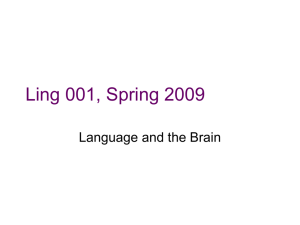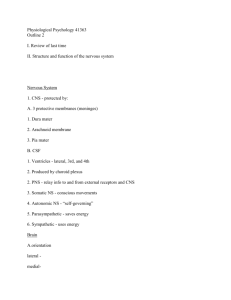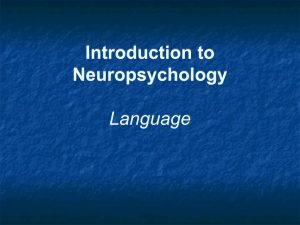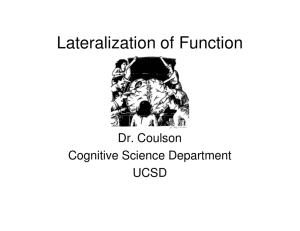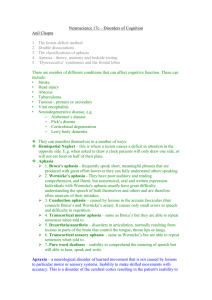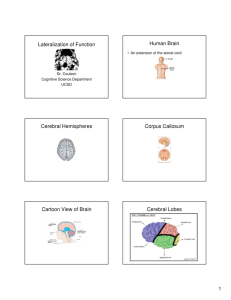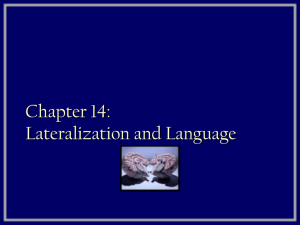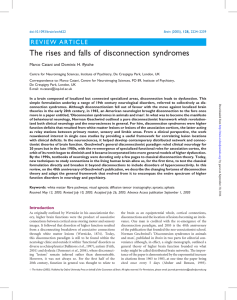****** 1
advertisement
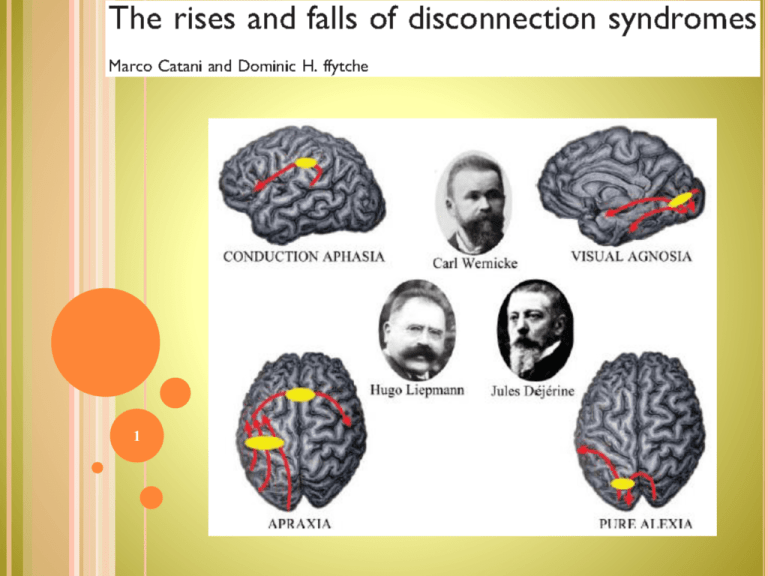
1 Disconnection Syndromes (DS) Higher function deficits resulted from lesions of white matter or the association cortices ‘Functional’ disorders such as schizophrenia, autism, dyslexia Founded on: Anatomy, post-mortem dissections, monkeys. More recently: DTI, Tractography 2 DS before Geschwind ‘The Classical associationist era’ Paradigm based on two central tenets: 1) Localization of function in discrete cortical areas 2) Connections between areas through white matter association pathways 3 DS before Geschwind Franz Joseph Gall (1758-1828): White matter Grey matter Phrenology (England) 4 DS before Geschwind Theodor Meynert (1833-1892): White matter fibers: 1) Projection fibers 2) Commissural fibers 3) Association fibers 5 DS before Geschwind Karl Wernicke (1848-1904): The father of Disconnection theory ‘fundamental psychic elements’ / ‘memory images’ “… mediated by means of their manifold connections via the association fibres” (Wernicke, 1885) 6 DS before Geschwind Karl Wernicke (1848-1904): Higher functions arise through associative connections, Disorders of higher function from their breakdown Critisizm: No cortical specialization other than motor/sensory Theoretical framework explained classical DS 7 Conduction Aphasia Motor component (Broca) Sensory component (Wernicke) Lesions: Broca Pure motor aphasia Wernicke Pure sensory aphasia Arcuate Fasciculus Conduction aphasia 8 Visual Agnosia Lesions: Cortical (Visual cortex) Apperceptive agnosia Trans-Cortical (associative fiber connections) Associative agnosia 9 The apraxias Hugo Liepmann (1863-1925) Higher movement disorders Spontaneous movements Planned gestures Disconnection of visual, auditory and somatosensory areas from motor area 10 The apraxias Left hemisphere dominant for complex movements control Lesions: Left parietal lobe bilateral apraxia Anterior portion of corpus callosum Unilateral apraxia (left) Left motor area (not shown) bilateral apraxia + right paresis 11 Pure Alexia Jules Déjérine (1849-1917) Left angular gyrus = visual verbal centre Lesions: Left angular gyrus Alexia + Agraphia Left central white matter occipital lesion Pure alexia 12 The fall of the classical era Déjérine model suggested Higher functions located in cortex An area specialized for higher visual function outside the visual cortex Wernicke’s opposition to higher functional centers The early 20th century (holistic, anti-localizationist) 1965 (localization theory, DS) 13 Geschwind’s neo-associationism Flechsig’s rule Include sensory and motor cortices and interhempispheric connections Association cortex acted as an obligatory relay station Phylogenetic perspective Higher-order association area in the parietal lobe Connections that did not depend on the limbic system 14 Geschwind’s neo-associationism The role of the angular gyrus: Déjérine visual memories of letters and words Geschwind forming multimodality associations Geschwind focused on DS caused by lesions of association cortex (parietal lobe) “…A ‘disconnexion lesion’ will be a large lesion either of association cortex or of the white matter leading from association cortex” (Geschwind, 1965) 15 Disconnections between sensory areas and limbic cortex Failure of a stimulus to evoke memories/affective response Disconnections between limbic lobe and Somatosensory cortex pain asymbolia Auditory cortex verbal learning impairment etc. Visual system (indirect connections) no symptoms 16 Disconnections between sensory areas and Wernicke’s area Modality-specific language deficits Disconnections can be direct or indirect (through the angular gyrus) Four syndromes: Tactile aphasia/Anomia Pure word deafness Pure alexia Modality-specific agnosia 17 Disconnections between sensory areas and motor cortex Left hemisphere disconnections: Hand motor cortex from posterior sensory areas Apraxia Broca’s area from Wernicke’s Conduction aphasia 18 19 DS After Geschwind Geschwind contribution: 1. Association cortex as an obligatory relay 2. Hierarchies of associations within the IPL 3. Importance of IPL in phylogeny and ontogeny of language Two research paths: Damasio (CT, PET, SPET) Mesulam (Tracing neural connections, computation theory etc.) 20 Contemporary neuroanatomical basis of higher brain functions Functional subdivision of the association cortex ‘Extended territories’ composed of specialized cortical subregions serving different but related functions Parallel, bidirectional, distributed processing 21 Contemporary neuroanatomical basis of higher brain functions Two key elements underlie higher function deficits: 1. Loss of specialized cortical function 2. Damage to connecting pathways Recent techniques enable research of disorders caused by hyperconnection and cortical hyperfunction 22 Hodotopic framework of clinicopathological correlations Territories composed of specialized subregions Intra-territorial connections (U-shaped) Inter-territorial connection (Long) 23 Hodotopic framework of clinicopathological correlations Topological mechanism (Topos = place) Prosopagnosia, face hallucinations Hodological mechanism (Hodos = road / path) Conduction aphasia, autism 24 Hodotopic framework of clinicopathological correlations 25 Language network disorders Direct (Long segment) Indirect (Anterior, Posterior) Pure hodological mechanism: Long segment Conduction aphasia Long, anterior, posterior Global aphasia 26 Language network disorders Direct (Long segment) Indirect (Anterior, Posterior) Pure topological mechanism: Anterior portions of Geschwind’s Non-fluent aphasia All of Geschwind’s Mixed trans-cortical aphasia All of Geschwind’s + deep white matter Global aphasia 27 Language network disorders Direct (Long segment) Indirect (Anterior, Posterior) Hyperfunction: Indirect Semantically based sympthoms Direct Excessive repetition (e.g. echolalia) 28 Praxis network disorders Med. Frontal Med. Parietal (DMPF, yellow) Motor SPL (DLFP, green) Motor IPL (VLFP, red) Lesions: SPL Depends on which praxic subfunctions are affected SPL + White matter Additional abnormalities 29 Visual network disorders Indirect (U-shaped occipito-temporal, red) Direct (Inferior longitudinal fasciculus, green) Lesions: Direct specific deficits related to the cortical specializations lost Indirect + medial white matter Visual hypo-emotionality / Visual amnesia 30 Visual network disorders Direct (Inferior longitudinal fasciculus, green) Indirect (U-shaped occipito-temporal, red) Hyperfunction: Indirect Visual hallucinations Hyperconnectivity: Indirect / Direct Unclear (Synaesthesia? Phobia?) 31


